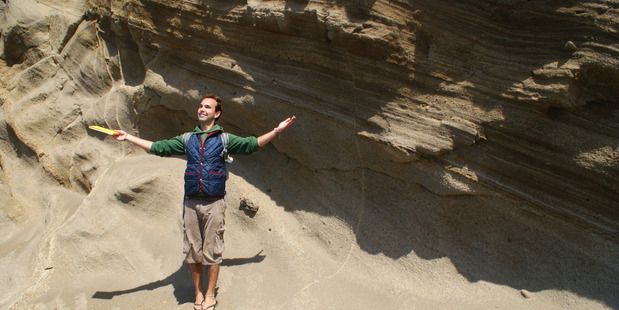Secrets of ancient NZ volcanoes revealed
 Researcher Ben Moorhouse, pictured here at Cape Wanbrow near Oamaru, has revealed the bizarre history of ancient eruptions from different volcanoes over millions of years apart. Photo / supplied
Researcher Ben Moorhouse, pictured here at Cape Wanbrow near Oamaru, has revealed the bizarre history of ancient eruptions from different volcanoes over millions of years apart. Photo / supplied The world was left captivated by an island that was rapidly and dramatically created by an underwater volcanic eruption in Tonga in March.
But new research has suggested something similar - yet perhaps more remarkable - once took place right here in New Zealand.
It was long believed that Cape Wanbrow - a rugged, windswept chunk of the South Island coast, south of Oamaru Harbour - was partly built by a monogenetic, or one-off, eruption when that part of the country was still underwater, between 30 and 40 million years ago.
Read more:
• Next Auckland eruption: Should you worry? Map pins volcano risk spots
• Huge blow if eruption hit factory zones
Yet, as an Otago University PhD researcher has found, it wasn't just one blast - or even one volcano - that was responsible for building up the land.
Unlike the monogenetic eruption that gave birth to the as-yet unnamed new island in Tonga this year, this area was constructed by different volcanoes and eruptions, at the same spot but in isolated events that took place millions of years apart.
Ben Moorhouse says his findings, published in the Journal of Volcanology and Geothermal Research, may change our understanding of what are supposed to be single-shot volcanoes.
As the eruptions at cape happened underwater, the deposits were eroded away by tides until they were almost gone.
But the layering of those deposits have been preserved in its bare cliffs, allowing Mr Moorhouse to reconstruct the events that took place.
At first, he expected the records to confirm to him there had been a single monogenetic underwater volcano.
"But once I looked at it from off-shore, there were clear margins between some of the layers, and when we examined those boundary layers it was evident that these different deposits were millions of years apart in age."
The last build-up at this site was on top of an eroded pedestal made up of extremely similar deposits - representing remnants of a series of previous volcanoes.
"It's like a modern city built on ancient ruins, but all constructed by the same family of architects and builders."
The repeated rise of magma to the same location across millions of years was different to the widely accepted idea that monogenetic volcanoes were single short lived eruptions.
"If true, why is magma preferentially rising in a spot where the plumbing system has frozen instead of creating a new pathway to the surface?" he said.
"Because, for some bizarre reason, at this site we have six volcanoes preferentially picking one spot, with millions of years apart."
--
__._,_.___

No comments:
Post a Comment